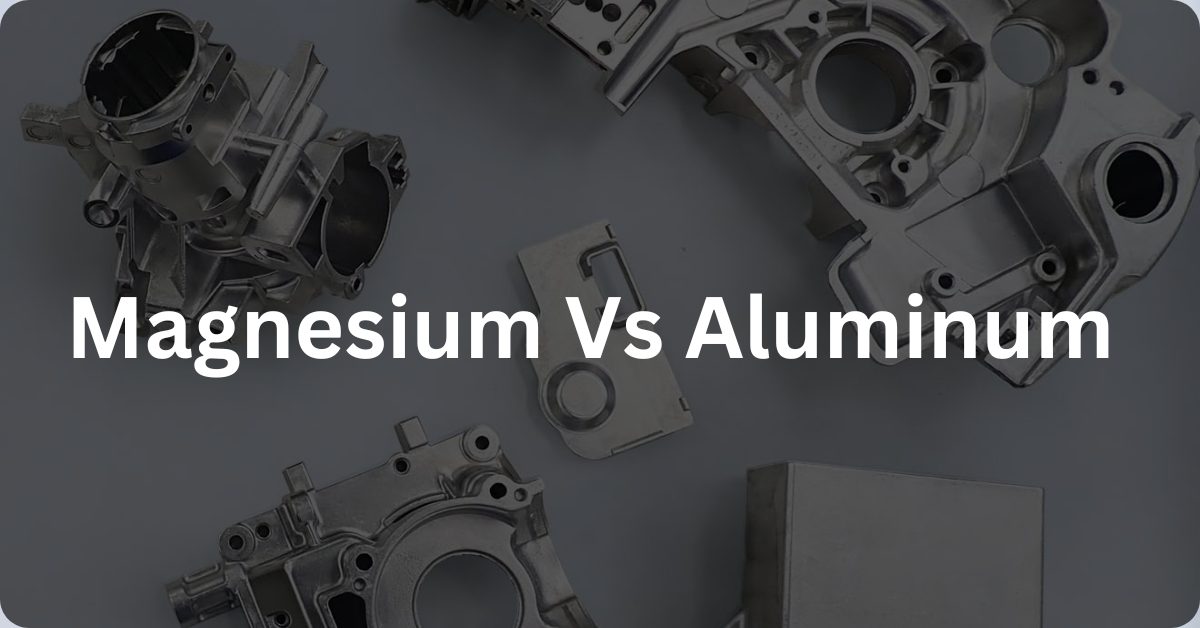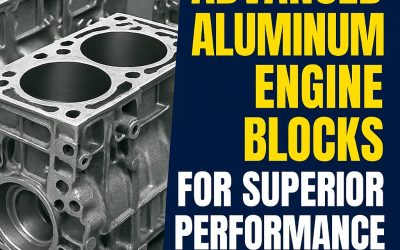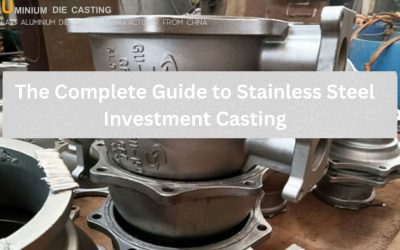Magnesium is a lightweight, strong metal. It is commonly used in the aerospace and automotive industries. Conversely, aluminum is known for its durability and versatility. It is equally essential in these fields. Both metals are crucial in die casting process. They significantly reduce weight and improve efficiency in various applications.
This article compares their properties, uses, and advantages. We’ll analyze their strengths and weaknesses. That will help you choose the best material for your needs.
Chemical Composition and Structure of Aluminum and Magnesium
Elemental Properties
Magnesium and aluminum are both low-weight metals. They possess distinct elemental properties.
- Atomic Structure
- Periodic Table Placement
- Inherent Characteristic
Atomic Structure
- Magnesium’s atomic number is twelve. It is part of the alkaline earth metals. Its atomic structure includes two electrons in its outer shell. That makes it highly reactive.
- Aluminum has an atomic number of thirteen. They belong to the post-transition metals. Its outer shell has three electrons. That contributes to its strength and stability.
Periodic Table Placement
- Group 2 of the periodic table contains magnesium. It is known for its lightweight and high reactivity.
- Aluminum is placed in Group 13, with properties. That includes good strength and ductility. Its position indicates versatility. They provide higher resistance to corrosion compared to magnesium.
Inherent Characteristics
- Magnesium is highly flammable. That requires careful handling, especially in the air. It has a lower melting point than aluminum. This may have an impact on its application at extreme temperatures.
- Aluminum creates a protective oxide layer in the air. That makes it more stable and less reactive. It is generally more durable. They are versatile in various industrial applications.
Density and Weight
The density and weight of magnesium and aluminum play significant roles in their applications.
- Density Comparison
- Weight Considerations
Density Comparison
- Magnesium has a 1.74 g/cm³ density. It makes it one of the lightest metals available. This low density is advantageous for reducing weight in applications. For instance, aerospace components.
- 70 g/cm³ is the density of aluminum. It is higher but still relatively light compared to other metals. Its density balances weight and structural strength. That makes it versatile.
Weight Considerations
- Magnesium’s lower density contributes to its use in applications where weight reduction is critical. Its lightweight nature helps enhance efficiency and performance in many industries.
- Aluminum metals are heavier. Still, they offer substantial weight savings compared to other materials. It is suitable for structural applications. That requires a combination of strength and reduced weight.
Mechanical Properties
- Strength and Durability
- Corrosive Resistance
1. Strength and Durability
Aluminum and magnesium are significantly different. They provide diverse mechanical properties.
- Tensile Strength
- Fatigue Resistance
- Hardness
Tensile Strength
- Magnesium has lower tensile strength. It ranges from 200–350 MPa.
- 310 to 550 MPa is the range of aluminum’s tensile strength. This makes it stronger. That allows it to handle greater loads and stresses.
Fatigue Resistance
- Magnesium exhibits lower fatigue resistance compared to aluminum.
- Aluminum’s superior fatigue resistance. That makes it ideal for dynamic and cyclic loading conditions.
Hardness
- Magnesium is softer. It is less rigid than aluminum. That impacts its wear resistance.
- Aluminum’s hardness varies with alloying. It offers better resistance to wear and deformation.
2. Corrosive Resistance
Both metals have different levels of corrosion resistance. That influences their applications.
- However, magnesium is more prone to corrosion. It is ideal for moist environments. It needs protective coatings or treatments. That helps enhance its longevity.
- Aluminum naturally forms a protective oxide layer. That shields it from corrosion. This oxide layer significantly enhances its resistance to environmental factors. It often requires less maintenance. They need fewer coatings compared to magnesium.
Conductivity of Electricity and Thermal
- Conductivity of Thermal
- Electrical Conductivity
1. Conductivity of Thermal
Aluminum’s and magnesium’s heat conduction characteristics differ greatly. Discover their comparison for the following conductivity:
Magnesium’s Thermal conductivity
156 W/m·K is the thermal conductivity of magnesium. It effectively dissipates heat in applications. For instance, electronics and engines. This ability to conduct heat helps manage temperatures in various devices.
Aluminum’s Thermal conductivity.
237 W/m·K is the thermal conductivity of aluminum. That is higher. It is effective for heat sinks and thermal management systems. Their superior heat conduction benefits industries. That requires efficient temperature control.
2. Electrical Conductivity
Magnesium and aluminum also differ in electrical conductivity.
- Magnesium Electrical Conductivity
- Aluminum Electrical Conductivity
Magnesium Electrical Conductivity
The electrical conductivity of magnesium is approximately 35.4 x 10^6 S/m. This lower conductivity limits its use in electrical applications. It is less efficient for electrical components compared to aluminum.
Aluminum Electrical Conductivity
The electrical conductivity of aluminum is greater. It is at around 37.7 x 10^6 S/m. This metal is suitable for wiring and electrical components. Their higher conductivity supports efficient electricity transfer. It reduces energy loss.
Applications in Aerospace and Automotive Industries
Aerospace Applications
- Magnesium and aluminum are crucial in aerospace. They serve different roles. Magnesium is preferred for specific components due to its low weight. Its lightweight nature helps reduce overall aircraft weight. That improves fuel efficiency. This metal is used in parts like engine blocks and wheels.
- Aluminum is widely used in aircraft structures. It offers strength and durability. This is ideal for fuselage and wing components. It provides a balance of weight and strength. That helps maintain structural integrity while keeping the aircraft light.
Automotive Applications
Magnesium is used in car parts to reduce weight. That improves fuel efficiency. It is found in wheels, engine parts, and transmission cases. The lower weight helps enhance vehicle performance and fuel economy.
Aluminum is used in many car parts. That includes engines and body panels. It offers strength while keeping weight down. They boost fuel efficiency. The properties of this metal help manufacturers meet strict fuel economy standards.
Manufacturing and Machining
Magnesium and aluminum are used in various manufacturing processes. Both metals are used for precision components in different industries.
Ease of Manufacturing
- Casting
- Welding
- Machining
Casting
- Magnesium is easier to cast. It possesses a low melting point. This metal can produce complex shapes. That may not have defects compared to aluminum.
- Aluminum also casts well but requires higher temperatures.
Welding
- Magnesium is more challenging to weld because it is highly reactive. It needs specialized techniques and equipment to prevent defects.
- Aluminum is easier to weld. This feature makes it a popular choice for structural components. It requires less specialized equipment compared to magnesium.
Machining
- Magnesium is softer. It is easier to machine. But can be more abrasive on tools.
- Aluminum is also easy to machine. It offers a better finish with less tool wear.
Both metals are machinable. However, they require different tools and techniques.
Recycling and Sustainability
Recycling and environmental impact are important factors for both metals.
- Magnesium is less commonly recycled. It has higher environmental costs. Its recycling process can be complex and energy-intensive.
- Aluminum is highly recyclable. It is more energy-efficient to process. This metal can be recycled indefinitely without losing quality. Its recycling has lower environmental impacts compared to magnesium. That makes it a more sustainable choice.
Cost Considerations
Material Costs
- Magnesium is generally more expensive than aluminum. It has limited availability. The extraction and refining process for magnesium adds to its cost. Market fluctuations can also impact magnesium prices.
- Aluminum is more cost-effective. It is more abundant and cheaper to extract. The production process is well-established. That helps lower costs. Its availability and lower extraction costs make it a more affordable option.
Production Costs
- Magnesium production can be more expensive. It involves complex processing and handling requirements. This metal needs specialized equipment and techniques. That is crucial for its casting, welding, and machining.
- Aluminum is generally more cost-effective to produce. It involves established processes. The widespread technology and infrastructure support their lower production costs. That offers long-term financial benefits for manufacturers. Its production efficiency can result in significant savings over time.
Advantages and disadvantages
| Aspect | Magnesium | Aluminum | Critical Considerations |
| Pros | ● Very light; ideal for weight-sensitive uses.
● High strength-to-weight ratio. ● Easy to machine. ● Good heat dissipation. ● Absorbs impact energy well. |
● Light, but heavier than magnesium.
● Good strength-to-weight ratio. ● Easy to machine and weld. ● Excellent heat conductivity. ● Highly corrosion resistant. ● Highly recyclable. |
Magnesium is superior in weight-sensitive applications. For instance, high-impact applications. While aluminum excels in corrosion resistance and recyclability. |
| Cons | ● Corrodes quickly, especially in moisture.
● Highly reactive, complicating handling. ● More expensive due to complex extraction. ● Highly flammable. ● Limited availability. ● Complex recycling process. |
● Heavier than magnesium.
● Less intense in specific high-stress uses. ● Lower fatigue resistance. ● Ductility issues in some conditions. ● Higher environmental impact in production. ● Susceptible to galvanic corrosion. |
Magnesium is less suitable. It is expensive in moist environments. While aluminum is more cost-effective. it is environmentally friendly. |
| Cost | More expensive due to complex extraction. | Cheaper and more abundant. | Aluminum is generally more affordable. It is widely available. |
| Recycling | Complex and less efficient. | Highly recyclable with an efficient process. | Aluminum has a clear advantage in sustainability. |
| Environmental Impact | Higher impact due to extraction and processing. | Higher impact due to energy-intensive production. | Both metals have environmental impacts. However, aluminum’s production is more energy-consuming. |
Conclusion:
Magnesium and aluminum serve different needs. Magnesium is lightweight and robust. This metal is ideal for aerospace parts. However, it is more expensive and corrodes quickly. Aluminum is heavier but resists corrosion well. It is cheaper than magnesium. Their utility lies in applications. That is related to automobiles and aerospace.
Aluminum offers good heat and electrical conductivities. Some necessary elements play a pivotal role in selecting the suitable metal. For instance, weight, cost, and corrosion resistance. You can get online quote for aluminum die casting from Aludiecasting company. Our company provides casting services for magnesium, zinc, and aluminum. Both have distinct advantages and are ideal for various uses. Understanding their properties helps in choosing the best material for each application.








0 Comments